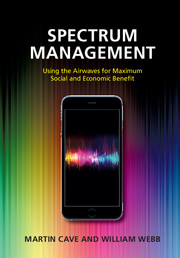Book contents
- Frontmatter
- Contents
- Preface
- Acknowledgments
- Plan of the book
- List of abbreviations
- Part I Fundamentals
- Part II Economic management of spectrum
- 4 Using auctions to assign spectrum
- 5 Other aspects of spectrum auction design
- 6 Spectrum trading
- 7 Spectrum pricing and valuation
- Part III Sharing and other emerging approaches to spectrum management
- Part IV Case studies and conclusions
- About the authors
- Index
- References
6 - Spectrum trading
from Part II - Economic management of spectrum
Published online by Cambridge University Press: 05 November 2015
- Frontmatter
- Contents
- Preface
- Acknowledgments
- Plan of the book
- List of abbreviations
- Part I Fundamentals
- Part II Economic management of spectrum
- 4 Using auctions to assign spectrum
- 5 Other aspects of spectrum auction design
- 6 Spectrum trading
- 7 Spectrum pricing and valuation
- Part III Sharing and other emerging approaches to spectrum management
- Part IV Case studies and conclusions
- About the authors
- Index
- References
Summary
Introduction
Auctions are episodic affairs. But with innovation being a distinctive feature of the wireless communication industry, it is desirable to have ready access to suitable frequency bands more regularly available. Spectrum trading is the process that allows the transfer of certain rights to use radio frequency spectrum from one undertaking to another. Smooth trading mechanisms enable the flow of spectrum resources among users and can contribute to providing speedier access to spectrum, compared to traditional administrative methods.
Historically, spectrum trades have not been possible between users entitled to rights on spectrum. Hence, in order to assign frequency bands to a different user, spectrum had to be returned to the spectrum manager and then reassigned – a much more rigid mechanism than secondary trading, with high transaction costs and little potential to inform on spectrum values [1].
The introduction of spectrum trading has a number of advantages. Spectrum trading makes it easier for prospective new market entrants to acquire spectrum and develop their business, it enables fast-growing companies to expand more quickly than would otherwise be the case, and it can provide considerable incentives for incumbents to invest in new technology in order to ward off the threat of new entrants. Therefore, spectrum trading promotes dynamic efficiency, as it encourages innovation, risk taking, and efficient use of inputs – including spectrum. Indeed, spectrum users can minimize costs by dynamically choosing the most efficient combination of spectrum and other production factors to deliver their goods and services.
For instance, after a primary spectrum assignment, either by an administrative procedure (e.g. “first-come, first-served”) or by a market mechanism (an auction), the holder of spectrum rights may realize that the value being attached to those rights is lower than another undertaking's valuation. In this case, it would not be efficient to leave spectrum in the hands of the current spectrum holder, as efficiency is usually achieved when the users of spectrum tend to be those with the highest valuations for the spectrum. A trade will only take place if the spectrum is worth more to the new user than it was to the old user, reflecting the greater economic benefit the new user expects to derive from the acquired spectrum [2].
- Type
- Chapter
- Information
- Spectrum ManagementUsing the Airwaves for Maximum Social and Economic Benefit, pp. 113 - 127Publisher: Cambridge University PressPrint publication year: 2015
References
- 2
- Cited by

